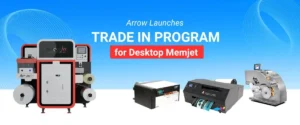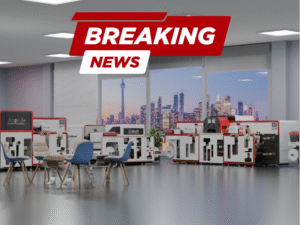Table of Contents
A Step-by-Step Guide to Setting Up Your Digital Label Printer
In today’s fast-paced business landscape, staying ahead of the curve is essential.
The demand for high-quality labels and flexible packaging has never been greater, making it imperative for companies to invest in top-notch digital label printers.
One such innovation that stands out in the industry is the ArrowJet Aqua 330R Lite. Let’s delve into the details of this cutting-edge technology and understand why it’s a game-changer.
The Significance of Digital Label Printers
In the era of e-commerce and ever-evolving customer preferences, businesses are constantly adapting to the changing market dynamics.
Digital label printers have become indispensable tools for businesses of all sizes. They offer a cost-effective and efficient solution for producing labels and packaging that align with market demands.
Traditional printing methods are no longer viable, as they are time-consuming and often result in excessive waste.
Digital label printers, on the other hand, streamline the printing process, offering high-resolution output, unparalleled flexibility, and the ability to adapt quickly to evolving designs and branding needs.
Meet the ArrowJet Aqua 330R Lite
Among the array of digital label printers available, the ArrowJet Aqua 330R Lite is a standout choice.
This remarkable device leverages the power of Memjet’s DuraFlex technology to deliver exceptional results.
We will discuss this printer’s features and specifications throughout this article, so stay with us.
Understanding Digital Label Printers
In this section, we will dive deeper into the world of digital label printers, exploring what they are, the various types available, the numerous advantages they offer, and the specific audience that will benefit most from this guide.
Furthermore, we will highlight the exceptional features of the ArrowJet Aqua 330R Lite that make it a standout choice in the realm of digital label printing.
What Are Digital Label Printers?
Digital label printers are advanced printing devices designed to produce labels, stickers, and flexible packaging materials using digital technology.
Unlike traditional printing methods, such as offset or flexographic printing, digital label printers do not require printing plates or extensive setup.
Instead, they use high-resolution digital images to create stunning, detailed, and vibrant labels with precision.
Different Types of Digital Label Printers
There are several types of digital label printers, each tailored to specific needs and production volumes. These include
Desktop Label Printers: Ideal for small businesses and low-volume label production, desktop label printers are compact, affordable, and easy to use.
Industrial Label Printers: These heavy-duty printers are designed for high-volume label production, offering speed and durability for large-scale operations.
Inkjet Label Printers: Utilizing inkjet technology, these printers excel in producing sharp, full-color labels and are versatile in accommodating various label sizes.
Laser Label Printers: Laser label printers use laser technology to create precise, high-quality labels, making them suitable for a wide range of applications.
Advantages of Using Digital Label Printers
The advantages of opting for digital label printers are numerous and include:
Cost-Effective: Digital label printing eliminates the need for costly printing plates and setup, resulting in reduced production costs.
Quick Turnaround: Digital label printers are high-speed, enabling businesses to produce labels on demand, meeting tight deadlines efficiently.
Customization: With digital technology, labels can be customized with variable data, perfect for personalized packaging and branding.
High-Quality Output: Digital label printers offer exceptional print quality with sharp graphics, vibrant colors, and intricate details.
Waste Reduction: Traditional printing methods often produce excessive waste in setup and plate creation. Digital label printers minimize this waste.
The Target Audience
This guide is designed for businesses of all sizes looking to enhance their label printing capabilities.
Whether you’re a small start-up, a medium-sized enterprise, or a large-scale production facility, understanding digital label printers and the advantages they offer is essential for staying competitive in today’s market.
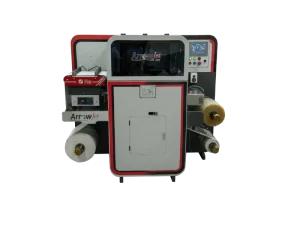
Features of ArrowJet Aqua 330R Lite
The ArrowJet Aqua 330R Lite, equipped with Memjet’s DuraFlex technology, stands out with its impressive features:
Single Printhead: The CMYK single printhead ensures stunning color reproduction and accuracy.
High Resolution: Offering 1600x1600dpi or 1600x954dpi, it excels in creating detailed and crisp labels.
Speed: With a production speed of up to 150 feet per minute, this printer guarantees efficiency.
Media Size: It can handle media up to 15 inches in width, catering to various label and packaging requirements.
Versatile Substrate Thickness: Ranging from 2 mils (0.05mm) to 13.75 mils (0.35mm), it accommodates a wide range of label materials.
Ink Options: Choose between 2L or 10L ink tanks for flexible printing solutions.
Optimal Operating Conditions: It operates at temperatures of 68-86°F (20-30°C) with humidity levels between 30-50%, ensuring consistent results.
Compact Design: With its compact dimensions, it fits well into any workspace.
Power and Connectivity: Requires a 3-phase 22V, 30A power supply, supporting 50/60 Hz and 6 bar for optimal functionality.
Selecting the Right Digital Label Printer
When it comes to selecting the right digital label printer for your business, thorough research, and careful considerations are crucial.
The choice you make will impact your label production efficiency, quality, and overall branding.
Research and Considerations
- Label Size and Format
Consider the size and format of the labels you need to produce. Different digital label printers are designed for various label dimensions.
Ensure the printer you select can accommodate your specific label requirements, from small stickers to larger packaging labels.
- Print Quality
Print quality is paramount. Look for a printer with a high resolution, as it directly impacts the clarity and vibrancy of your labels. A minimum of 1200 dpi is recommended for sharp, professional-looking labels.
The ArrowJet Aqua 330R Lite, for instance, offers an impressive 1600x1600dpi resolution for stunning results.
- Printing Speed
Production speed is a critical factor for businesses with high-volume label needs. If you require quick label turnaround, opt for a printer that can match your production pace.
The ArrowJet Aqua 330R Lite boasts a speed of up to 150 feet per minute, making it an ideal choice for fast-paced operations.
- Ink Options
Consider the ink options available. Some printers offer multiple ink tanks, allowing you to switch between colors easily or reduce downtime for ink replacement.
The ArrowJet Aqua 330R Lite provides both 2L and 10L ink tank options for added versatility.
- Connectivity Options
Modern digital label printers should offer a range of connectivity options to fit seamlessly into your workflow. Look for USB, Ethernet, and wireless connectivity to ensure easy integration with your existing systems.
- Software Compatibility
Ensure that the printer is compatible with your preferred design and printing software. Compatibility issues can lead to inefficiencies and errors in label production.
Necessary Equipment and Software for Digital Label Printing
When setting up for digital label printing, it’s essential to have the right equipment and software at your disposal.
Essential Equipment
- Digital Label Printer
The most crucial piece of equipment is, of course, the digital label printer itself. Select a printer that aligns with your specific label size and quality requirements.
The ArrowJet Aqua 330R Lite, as previously discussed, is a top choice due to its high resolution, fast production speed, and versatility.
- Label Media and Substrates
Choose the appropriate label media and substrates that match your label design and intended use. This includes rolls or sheets of label material in various sizes, materials, and adhesive types.
- Cutting and Finishing Equipment
Depending on your label design and production needs, you may require cutting and finishing equipment such as label cutters or die-cutters. These tools ensure your labels are accurately shaped and sized.
- Laminator and Coater (Optional)
If your labels need extra protection or a specific finish, a laminator and coater can be valuable additions to your setup.
- Label Rewinder and Unwinder
Label rewinders and unwinders ensure smooth and efficient label roll handling during the printing process.
- Label Inspection Equipment
To maintain quality control, label inspection equipment, including scanners and vision systems, can help identify and address any printing defects or errors.
- Label Applicators (Optional)
For businesses that require automated label application, label applicators can streamline the labeling process.
Compatible Software
- Label Design Software
Choose label design software that enables you to create and customize label designs. Popular options include
Adobe Illustrator: Known for its design capabilities, it’s a versatile choice for label design.
CorelDRAW: Offers robust vector graphics tools for label design.
Avery Design & Print Online: A user-friendly web-based tool for designing labels.
- RIP Software (Raster Image Processor)
RIP software optimizes the printing process, enhancing color accuracy and print quality. Common RIP software for label printing includes
Wasatch SoftRIP: Known for its advanced color management features.
ErgoSoft Roland Edition: Ideal for users of Roland printers.
- Label Printing Software
Software that facilitates the actual printing process is crucial. Many label printers come with their own proprietary printing software. Ensure that it’s compatible with your chosen printer.
- Variable Data Printing Software
For businesses that require personalized labels, variable data printing software is essential. It allows you to input variable data like barcodes, serial numbers, or customer names into your labels.
Bartender: Widely used for variable data printing.
NiceLabel: Offers both label design and variable data printing capabilities.
- Color Management Software
To ensure color consistency and accuracy, color management software can be beneficial. It helps in calibrating your printer and monitor for precise color reproduction.
X-Rite i1Profiler: Known for its color calibration features.
Setting Up Your Workspace for Digital Label Printing
Establishing a dedicated workspace for your digital label printer is a crucial step in ensuring efficient and high-quality label production.
Organizing Your Workspace
- Choose a Dedicated Location
Select a clean and well-lit area specifically for your digital label printer. Ideally, this space should be free from excessive dust, humidity, and direct sunlight. It’s essential to keep your printer away from any potential hazards.
- Sturdy Work Surface
Place your digital label printer on a sturdy and level work surface. Ensure that the surface can bear the weight of the printer and other necessary equipment. A dedicated table or countertop works well.
- Proximity to Power and Connectivity
Position your workspace near power outlets and network connections. This reduces the need for extensive cable management and ensures that your printer can be easily integrated into your existing systems.
- Storage and Organization
Have nearby storage for label media, substrates, ink, and any necessary accessories. This ensures that everything you need is readily accessible, reducing downtime and disruptions during printing.
- Label Inspection Area
Designate an area for label inspection and quality control. This area should have adequate lighting to check for any defects or printing errors before labels are dispatched.
Importance of Cleanliness
- Clean Environment
A clean workspace is essential for maintaining the integrity of your labels. Dust and debris can lead to imperfections in your printed labels. Regularly clean your workspace, including the printer, to prevent contaminants from affecting the printing process.
- Dust Management
Invest in dust covers for your printer when it’s not in use. Additionally, consider air purifiers or dust extraction systems to minimize airborne particles that can settle on your printer and labels.
- Label Handling Hygiene
When handling labels and substrates, ensure your hands are clean to prevent any transfer of oils or dirt onto the materials. Cleanliness in label handling contributes to the overall quality of your labels.
Importance of Ventilation
- Temperature Control
Maintain a consistent temperature in your workspace. Fluctuations in temperature can affect the performance and longevity of your digital label printer. Keep the temperature within the manufacturer’s recommended range.
- Humidity Control
Control humidity levels as well. High humidity can cause paper to warp and ink to smudge, while low humidity can lead to static issues. The ideal humidity range is typically 30-50%.
- Proper Ventilation
Ensure proper ventilation to disperse any fumes or heat generated during the printing process. Adequate ventilation not only prevents overheating but also creates a more comfortable working environment.
- Air Quality
Maintain good air quality with regular ventilation. Clean air not only benefits your health but also prevents dust and particles from settling on your printer and labels.
Installing and Configuring Your Digital Label Printer
Setting up your digital label printer, such as the ArrowJet Aqua 330R Lite, requires careful attention to detail to ensure smooth and trouble-free operation.
Below, you will find step-by-step instructions for unpacking and setting up the printer, installing the necessary software and drivers, and troubleshooting common installation issues.
Unpacking and Setting Up Your Printer
Unboxing: Carefully unpack your ArrowJet Aqua 330R Lite, ensuring that all components are present and undamaged. Common components include the printer, power cords, USB cables, ink cartridges, and user manuals.
Choose a Location: Select a dedicated workspace, as discussed in the previous section, and place your printer on a sturdy, level surface.
Connect Power: Plug in the power cord to the printer and a power outlet that matches the printer’s specifications. Ensure that the printer is grounded correctly.
Ink Installation: Install the provided ink cartridges. Follow the printer’s user manual for specific instructions on how to load ink cartridges properly.
Media Loading: Load label media into the printer’s media compartment according to the manufacturer’s guidelines.
Initial Test: Perform a test print to ensure that the printer is functioning correctly. This step can help identify any immediate issues.
Unpacking and Setting Up Your Printer
Software Download: Visit the manufacturer’s website to download the software and drivers for the ArrowJet Aqua 330R Lite. Make sure you are downloading the latest versions.
Software Installation: Run the software installation package and follow the on-screen instructions. Typically, this includes accepting the license agreement, specifying the installation directory, and choosing components to install.
Driver Installation: Connect your printer to your computer via the provided USB cable. The operating system should automatically detect the printer and attempt to install drivers. If not, use the drivers provided by the manufacturer.
Calibration and Configuration: After software and drivers are installed, configure the printer settings to match your label specifications, such as size and print resolution. Follow the instructions in the user manual for calibration.
Network Setup (If Applicable): If your printer is network-capable, configure network settings to allow multiple users to access the printer over the network.
Troubleshooting Common Installation Issues
- Driver Installation Issues
Ensure you are using the correct and up-to-date drivers for your operating system.
Uninstall any conflicting drivers or software from previous printers.
Check for Windows Updates or system updates to resolve driver conflicts.
- Ink Cartridge Problems
Verify that you have correctly installed the ink cartridges according to the manufacturer’s instructions.
Confirm that you have removed any protective seals or packaging from the cartridges.
- Media Feeding Problems
Make sure you have correctly loaded the label media and that it is compatible with your printer.
Check for any obstructions or debris in the media path that may be causing feeding issues.
- Connection Issues
Ensure that all cables are securely connected to both the printer and the computer.
Verify that the USB port is working correctly.
- Software Configuration Problems
Double-check the software settings to ensure that they match the printer’s specifications and the label size.
- Network Connectivity Problems (If Applicable)
Confirm that your printer is connected to the correct network.
Check your firewall and network settings to ensure they are not blocking printer communication.
Designing Labels: Basics and Tips
Creating labels that are both visually appealing and functional is essential for effective branding and communication.
Basics of Label Design
- Clarity and Readability
Prioritize clarity in your label design. Ensure that all text and graphics are easily readable.
Select legible fonts and appropriate font sizes. Avoid overly ornate or complex fonts.
- Color Selection
Choose a color palette that aligns with your brand identity. Consistency in colors helps with brand recognition.
Consider color psychology; different colors evoke different emotions and perceptions.
- Graphics and Images
Use high-quality images and graphics. Blurry or pixelated images can negatively impact your label’s professional appearance.
Ensure that images are relevant to your product or message.
- Label Size and Shape
Select a label size and shape that suits your product or packaging. It should not overwhelm or be too small for the container.
Square, rectangular, and round labels are common choices, but you can also consider custom die-cut shapes.
- Hierarchy of Information
Organize information hierarchically. The most crucial details, such as product name and key benefits, should be prominent.
Less critical information, like contact details or legal text, can be smaller but still legible.
- White Space
Don’t overcrowd your label with information. White space (empty areas) can enhance readability and create a clean, modern look.
- Branding Elements
Incorporate your brand logo and any associated branding elements like slogans or icons. They reinforce brand identity.
Tips for Attractive and Functional Labels
- Know Your Audience
Understand your target audience’s preferences and expectations. Tailor your label design to resonate with them.
- Compliance with Regulations
If your product falls under specific regulations, ensure that your label includes all legally required information, such as ingredients or safety warnings.
- Simplicity
Keep your design clean and simple. Unnecessary complexity can confuse consumers and detract from the main message.
- Typography
Choose fonts that match your brand’s personality. Fonts can convey different emotions, from elegance to playfulness.
Use bold or italics to emphasize key information.
- Product Image
Showcase your product through high-quality images. For food products, an image of the item can be enticing.
For non-visual products, use images or graphics that symbolize the product’s benefits.
- Material and Finish
Select the label material and finish that align with your product’s purpose. Options range from glossy to matte, textured to transparent.
Consider factors like durability and resistance to elements if the label will be exposed to moisture or sunlight.
- Testing
Before finalizing your label design, conduct testing to ensure that it’s legible and appealing to your target audience.
Seek feedback from others, including colleagues and potential customers, to gain different perspectives.
- Consistency Across Products
Maintain consistency in your label design if you have multiple products. A uniform style builds a recognizable brand image.
- Special Printing Techniques
Explore special printing techniques such as embossing, foil stamping, or 3D effects for a unique and eye-catching label.
- Adaptability
Design your label to be adaptable for various packaging sizes and shapes. This versatility can save costs in label production.
Compliance and Regulations in Labeling
Compliance with labeling regulations is crucial for businesses to ensure that their products are safe, accurately represented, and meet legal requirements.
Failure to adhere to these regulations can result in fines, recalls, and damage to your brand’s reputation.
Below, we’ll explain the basics of labeling regulations and provide resources for staying compliant with industry standards.
Labeling Regulations Overview
FDA Regulations (Food and Drug Administration):
In the United States, the FDA sets regulations for labeling food, drugs, cosmetics, and medical devices.
Labels must include specific information about ingredients, nutritional facts, allergens, and any health claims.
USDA Regulations (United States Department of Agriculture):
USDA regulates labels for meat, poultry, and egg products.
Labels must include product name, inspection mark, handling instructions, and safe handling instructions for raw meat and poultry.
FCC Regulations (Federal Communications Commission):
The FCC requires certain information on electronic products, such as mobile phones, to ensure electromagnetic compatibility and safety.
TSCA Regulations (Toxic Substances Control Act):
TSCA oversees chemical substances used in products to protect human health and the environment. Labels may need to include warnings about hazardous chemicals.
EPA Regulations (Environmental Protection Agency):
The EPA regulates labels for pesticide products, ensuring safe and effective use. Labels must include specific use instructions, warnings, and hazard statements.
International Regulations:
If your products are sold internationally, you must also comply with labeling regulations in the target countries, such as the EU’s food labeling regulations.
Conclusion:
In conclusion, setting up a digital label printing system involves careful organization, adherence to regulations, and a keen eye for design.
The ArrowJet Aqua 330R Lite stands out as a top choice, offering precision and speed. To succeed, remember to stay compliant, maintain a clean workspace, and follow best practices. Your label’s quality can be a game-changer in the competitive world of product branding.
Contact With Our Team Now
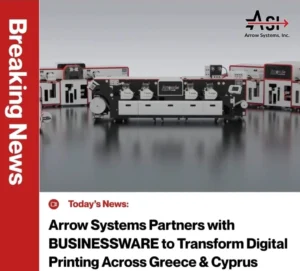
Breaking News: Arrow Systems Partners with BUSINESSWARE to Transform Digital Printing Across Greece & Cyprus

Sid Sistemas de Impresión in Spain Installs ArrowJet Aqua 330R and DPR Taurus to Bolster Label Production
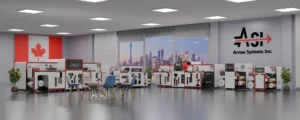
Step Inside Innovation: Arrow Systems New Experience Center Opens in Ontario, Canada.
